
Alien Species
Alien Species
"Alien species" means, with respect to a particular ecosystem, any species, including its seeds, eggs, spores, or other biological material capable of propagating that species, that is not native to that ecosystem.
From Executive Order 13112 of February 3, 1999 establishing the National Invasive Species Council.
Many alien species are welcome additions to the landscape.
- Most garden plants are not natives.
- Wheat, apricots, apples, peaches, oats, cabbage and many other foods are not native to North America.
- Tomatoes, potatoes, avocados, and chocolate are not native to Europe or Africa.
- Horses, dogs, cats, and cattle are not native to North America. (Well, horses were native millions of years ago, but those horses became extinct.)
But some alien species are not wanted. They are the invasive species.
Invasive Species
"Invasive species" means an alien species whose introduction does or is likely to cause economic or environmental harm or harm to human health.
From Executive Order 13112 of February 3, 1999 establishing the National Invasive Species Council.
Alien species are sometimes also referred to as exotic, non-native, introduced, nuisance and non-indigenous species.
From GulfBase.org.
Invasive species are perhaps the most important environmental problem along many coasts. Fortunately, they are not yet an important problem in the Gulf of Mexico. See the US Government Interagency gateway to Invasive Species.
How Do Invasive Species Succeed?
Successful alien fish are species that are ecological generalists that "grew
relatively faster, tolerated wider ranges of temperature and salinity,
and were more likely to have a history of invasiveness than were fishes
[that failed to invade successfully]."
Kolar & Lodge (2002).
What Are the Important Invasive Species?
- The Nonindigenous Species Database Network NISbase provides links to information about invasive species.
- The World Conservation Union's Invasive Species Specialist Group maintains a global database and a list of the 100 worst alien species worldwide, including land plants and animals.
- The US Geological Survey maintains a list of Nonindigenous Aquatic Species and alien species in San Francisco bay.
- The state of Hawaii lists the important alien marine species of Hawaii.
- NOAA lists several invasive species, including Asian Tiger Shrimp, and Lionfish in the Gulf of Mexico and South Atlantic Regions. Other important species include Green Mussels, Zebra Mussels, which has recently reached the gulf, Pacific white shrimp, the Tessellated blenny, and the Taura Virus of farmed shrimp, which may escape into the gulf. Full details are in their Gulf of Mexico Regional Panel 2002 Annual Report.
In Hawaii, the spread of invasive algae has washed ashore and formed stinking piles that have driven off tourists.
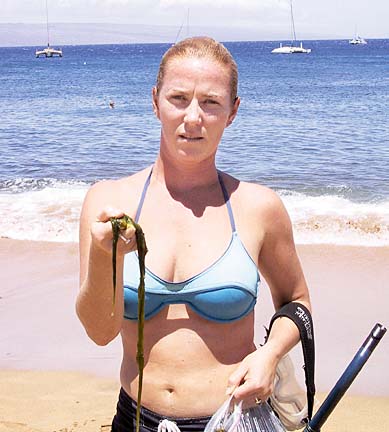
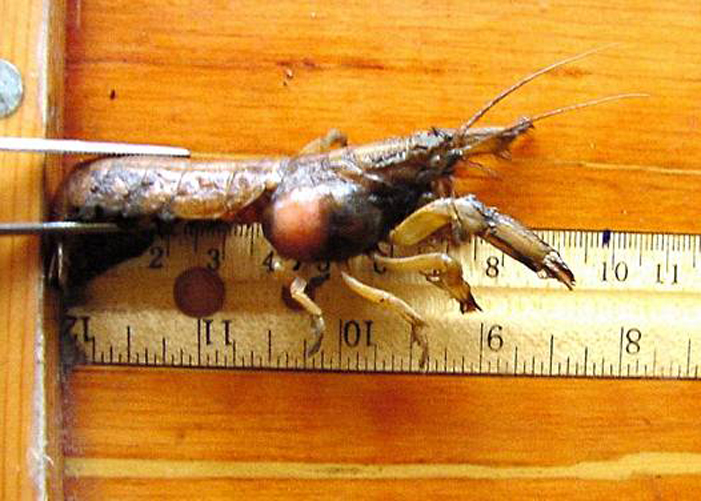
GARY T. KUBOTA / GKUBOTA@STARBULLETIN.COM
Left: Researcher Jennifer Smith displays
the green seaweed (a green algae Cladophora sericea) that is
plaguing a section of the coastline in West Maui. Residents and visitors
have complained about the foul odor and murky diving conditions.
From Hawaii Star Bulletin.
Right: The parasitic isopod Orthione griffenis,
which likely was introduced to the West Coast via ship ballast water, infests
native mud shrimp and can be identified by its bulging carapace. Click
on the image for a zoom. (Courtesy of Brett Dumbauld)
From Oregon State University New Invasive Parasite
How Do Invasive Marine Species Spread?
- Aquaculture. The Food and Agriculture Organization estimates that
39% of new, alien, aquatic species are introduced for aquaculture.
Aquaculture was the main reason for the deliberate
movement of aquatic species across national borders.–FAO
Most aquaculturists are careful not to release exotics into new environments. However, unintentional releases do occur. In the Northwest, Atlantic salmon have escaped through holes in net pens, and have been captured by commercial fishermen. There is concern that they may compete for food or nesting sites with native Pacific salmon.
From MIT Sea Grant Center for Coastal Resources.
The Caulpera taxifolia species described below was apparently inadvertantly released into the Mediterranean Sea by the Oceanographic Museum at Monaco, although they insist the plant did not come from the museum.
- Marine
Trash.This article and the original
paper in Nature by David
Barnes (2002) describes the great increase in the number of marine
organisns transported to new regions on marine trash, especially
plastics.
[He] estimate[s] that rubbish of human origin in the sea has roughly doubled the propagation of fauna in the subtropics and more than tripled it at high (> 50°) latitudes, increasing the potential for alien invasion and adding to the problems already created by sea-borne plastic materials in the form of injuries and mortality among marine mammals and birds.
Barnes examined about 200 items of debris washed ashore on each of 30 islands, which were scattered over a geographical range extending from Spitsbergen in the Arctic to Signy Island in the Antarctic. [He] found that 20–80% of this debris was anthropogenic (man-made) in origin. Many types of animal use marine debris as a mobile home, particularly bryozoans, barnacles, polychaete worms, hydroids and molluscs (in order of abundance), and I found that among the most numerous were animals with cosmopolitan distributions.
Barnes (2002).
- Ship's
Ballast Water.
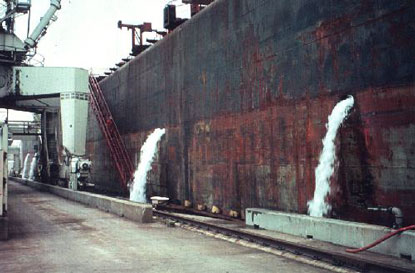
Ballast water being pumped from a ship in port.
From MIT Sea Grant Center for Coastal Resources.
Ballast water is fresh or saltwater held in the ballast tanks and cargo holds of ships. It is used to provide stability and maneuverability during a voyage when ships are not carrying cargo, not carrying heavy enough cargo, or when more stability is required due to rough seas. Ballast water may also be used to add weight so that a ship sinks low enough in the water to pass under bridges and other structures.
Usually ballast water is pumped into ballast tanks when a ship has delivered cargo to a port and is departing with less cargo or no cargo. Ballast water is then transported and released at the next port-of-call where the ship picks up more cargo. If a ship is receiving or delivering cargo to a number of ports, it may release or take on a portion of ballast water at each port. In such cases, the ship’s ballast water contains a mix of waters from multiple ports.
From MIT Sea Grant Center for Coastal Resources.
Some Infamous Invasive Species
- America's Least Wanted (1.2 MB PDF file) are listed by Conserve Online, a "one-stop" online, public library, created and maintained by The Nature Conservancy in partnership with other conservation organizations.
- European
Green Crab.
The European green crab first entered the U.S. in the mid 1800's, coming by sailing ship to the Cape Cod region. In the early 1900's they spread northwards, arriving in Maine in the 1950's they are believed to have contributed to the dramatic declines in the soft shell clam fishery. Soon they had migrated all the way up to Nova Scotia. In 1989 they were discovered on the West Coast, in San Francisco Bay. They may have come in the ballast water of ships, they may have been shipped over hidden in the kelp packing around live main lobsters or Atlantic bait worms... In areas where the crab have been able to establish reproducing populations they have had dramatic impacts on other species, particularly smaller shore crab, clams, and small oysters. While the crab cannot crack the shell of a mature oyster, it can prey upon young oysters, and will dig down six inches to find clams to eat. One green crab can consume 40 half-inch clams a day, as well as other crabs its own size.
From Washington Department of Fish and Wildlife.
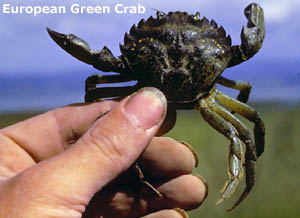
European Green Crab (Carcinus maenas).
From Washington Department of Fish and Wildlife Aquatic Nuisance Species
- Caulpera
taxifolia on the US west coast, including its Invasion
of a lagoon near San Diego. More info see San
Diego Regional Water Quality Board.
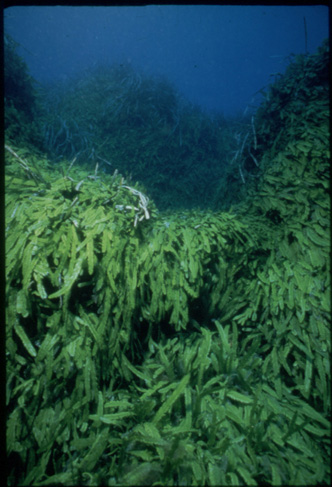
Caulpera taxifolia covering the sea floor in the Mediterranean Sea offshore of Monaco. It was introduced to the Mediterranean in wastewater from the Oceanographic Museum at Monaco where it now covers over 13,000 hectares of seabed along 190 km of coast.
From Global Invasive Species Database.
- Lionfsh in Southeast
Atlantic.
Lionfish, a native of the Indian and Pacific oceans, are now considered established in the Atlantic Ocean. First discovered off the coast of North Carolina in 2000 by the NOAA National Centers for Coastal Ocean Science, they are believed to have been present off the east coast of Florida since the mid 1990s. Lionfish, popular in the aquarium trade, were likely introduced through releases by amateur aquarists no longer wishing to keep the fish.
Reported by NOAA Center for Coastal Fisheries and Habitat Research.
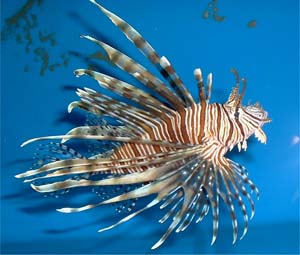
Lionfish collected taken in 2005 NOAA survey offshore of North Carolina.
From NOAA Press Release on Lionfish.
- Mitten
Crab in bays and estuaries. This asian species is rapidly invading
brackish water in bays and estuaries on the east and west coast.
The Chinese mitten crab (Eriocheir sinensis) is a migrating crab which has invaded Europe and, more recently, North America. It contributes to the local extinction of native invertebrates and modifies habitats. As well as causing erosion by its intensive burrowing activity, the crab may cost fisheries and aquaculture industries several of hundreds of thousands of dollars per year by stealing bait and feeding on trapped fish. The female carries 250,000 to 1 million eggs and control strategies such as electrical screens have failed to prevent crab migration.
From Global Invasive Species Database.

Mitten crab.
From Global Invasive Species Database.
Reference
Barnes, D. K. A. (2002). "Biodiversity: Invasions by marine life on plastic debris." Nature 416 (6883): 808-809.
Kolar, C. S. and D. M. Lodge (2002). "Ecological Predictions and Risk Assessment for Alien Fishes in North America." Science 298(5596): 1233-1236.
Revised on: 30 May, 2017
